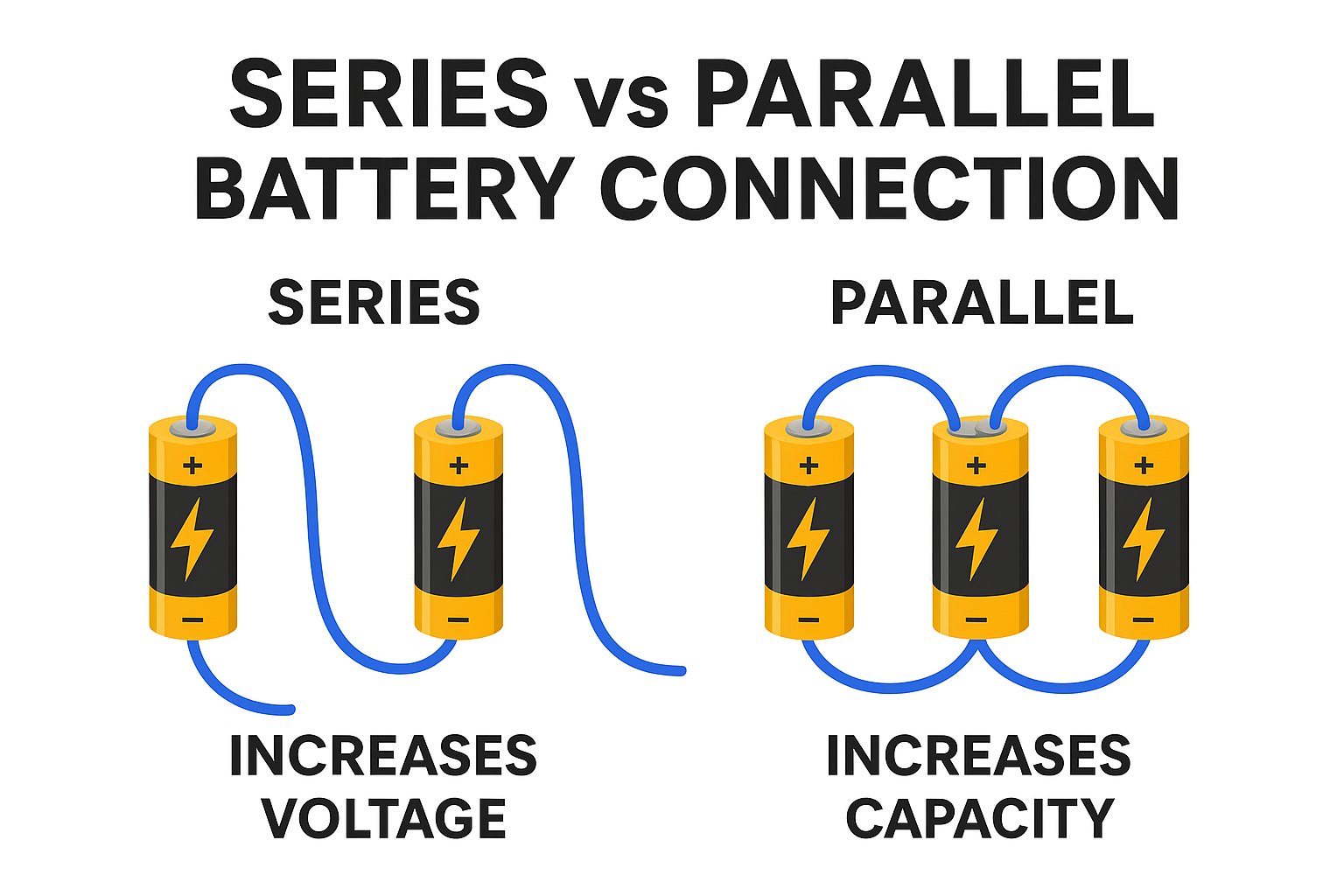Batteries are the backbone of modern electronics, from small remote controls to large power backup systems. But when we need higher voltage or more power capacity, a single cell is often not enough. This is where series and parallel battery connections come into play. Understanding how to connect cells in series and parallel is one of the most important fundamentals in electronics, robotics, renewable energy systems, and DIY projects.
In this article, we will cover everything you need to know about series connection and parallel connection of batteries, their differences, advantages, disadvantages, applications, and step-by-step connection methods. By the end of this guide, you will be able to design and build your own power supply according to your project’s requirements.
What is a Series Battery Connection?
When batteries are connected end to end, i.e., the positive terminal of one battery is connected to the negative terminal of the next battery, it is called a series connection. In a series arrangement, the voltages of all the batteries add up, but the current capacity (Ah rating) remains the same as a single cell.
Formula:
Total Voltage = V1 + V2 + V3 + …
Total Current = Same as the current of one cell (Ah does not increase)
Example:
If you connect four 1.5V AA batteries in series, the total voltage will be:
1.5V + 1.5V + 1.5V + 1.5V = 6V.
But if each cell is 2000mAh (2Ah), then the total capacity remains 2000mAh (2Ah).

What is a Parallel Battery Connection?
In a parallel connection, all the positive terminals of the batteries are connected together, and all the negative terminals are also connected together. In this case, the voltage remains the same as a single cell, but the current capacity (Ah rating) increases.
Formula:
Total Voltage = Same as one cell
Total Current = Ah1 + Ah2 + Ah3 + …
Example:
If you connect four 1.5V AA batteries in parallel, the total voltage will still be 1.5V.
But if each battery has a capacity of 2000mAh (2Ah), then the total capacity becomes:
2000mAh + 2000mAh + 2000mAh + 2000mAh = 8000mAh (8Ah).

Key Difference Between Series and Parallel Battery Connection
| Feature | Series Connection | Parallel Connection |
|---|---|---|
| Voltage | Adds up (Vtotal = V1 + V2 + …) | Same as a single cell |
| Current (Capacity) | Same as a single cell | Adds up (Ah increases) |
| Power Output | Higher voltage for devices requiring more volts | Higher current for devices requiring more runtime |
| Example Application | Torch, Inverter battery banks | Power banks, Solar storage systems |
Series and Parallel Combination
Sometimes, just connecting in series or parallel may not be enough. In many applications (like solar panels, electric vehicles, UPS systems), batteries are connected in a series-parallel combination. This gives both higher voltage and higher current capacity. For example, 4 batteries connected in series to increase voltage, and then multiple such series strings connected in parallel to increase current.
Advantages of Series Connection
- Provides higher voltage required for many electronic devices.
- Simpler wiring design compared to parallel connection.
- Used where high voltage efficiency is needed.
- Better suited for long-distance power transmission (reduces losses).
Disadvantages of Series Connection
- If one battery fails, the entire series circuit breaks.
- Capacity remains the same, so backup time doesn’t increase.
- Charging becomes complex as all cells must be balanced equally.
Advantages of Parallel Connection
- Increases total current capacity (longer backup time).
- If one battery fails, others can still supply power.
- Safer for low-voltage applications.
- Better for devices requiring longer runtime at constant voltage.
Disadvantages of Parallel Connection
- Voltage remains the same, cannot power high-voltage devices.
- Unequal charging/discharging can cause imbalance.
- Requires thicker wires due to high current flow.
Applications of Series and Parallel Connections
Series Applications:
- Torches and flashlights
- Laptops and high-voltage devices
- Inverter and UPS systems
- Electric vehicles
Parallel Applications:
- Power banks and mobile backup systems
- Solar panel battery storage
- Low-voltage DC circuits
- Emergency lighting systems
Safety Tips While Connecting Batteries
- Always use batteries of the same voltage and capacity.
- Do not mix old and new batteries together.
- Ensure correct polarity while making connections.
- Use proper battery holders or insulated wires.
- For large systems, use a Battery Management System (BMS).
- Never short-circuit the terminals.
- Ensure proper charging and discharging cycles.
Conclusion
In summary, series connection increases voltage, while parallel connection increases current capacity. Both methods are widely used depending on the requirement of the device or system. For example, if your circuit needs higher voltage (like 12V or 24V), you should go for series connection. If your circuit needs more backup time at the same voltage, then parallel connection is the better option. And in many cases, both connections are combined for maximum efficiency.
Understanding these concepts not only helps in small DIY projects but also forms the foundation of advanced systems like solar energy storage, electric vehicles, and industrial backup systems. Whether you are a student, hobbyist, or professional engineer, mastering series and parallel battery connections is essential knowledge for working with electronics and electrical systems.
We hope this complete guide on series vs parallel battery connection has helped you understand the topic in detail. If you still have any doubts, feel free to ask in the comment section below!
